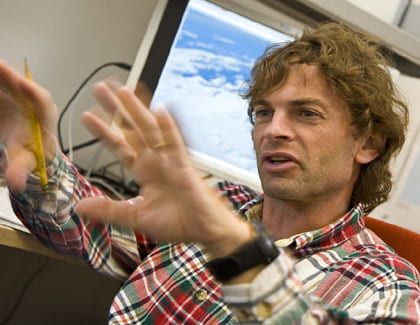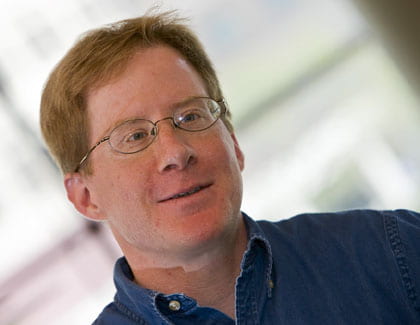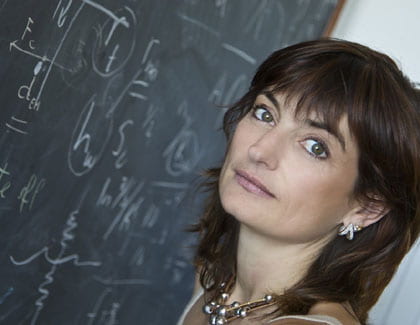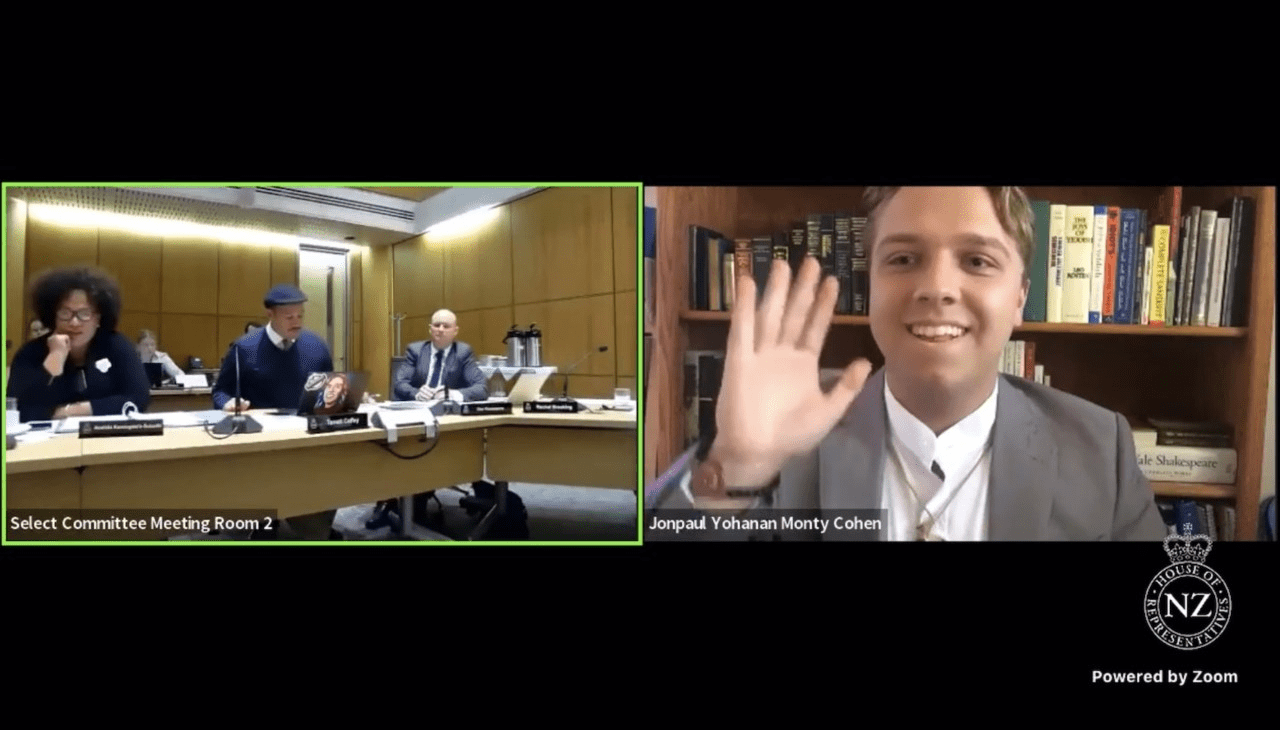Hot shots
New researchers elevate climate change research
Global climate change is projected to accelerate through the 21st century and affect ecosystems that preserve our planet’s habitability. UCI’s Department of Earth System Science focuses on how the atmosphere, land and oceans interact as a system – and how the Earth will change over a human lifetime. Little more than a decade after its founding, it is considered one of the most influential academic departments in the nation devoted to studying Earth as a system.
Five young researchers joined the department in 2006, recruited from around the world to join scientists working across many disciplines to understand global warming, stratospheric ozone depletion and worldwide air pollution.
Meet the new faculty members – the spelunker, the husband-wife team studying glaciers and topography, the sun-burned Antarctic camper keeping his eye on ice, and the native of Italy whose concern is ocean warming.
The magnificence of ice
As a boy, Eric Rignot enjoyed snowy winters in Massif Central, France. Long before he began studying the effects of global warming, he noticed a change. “In a nonscientific way, I observed that mountain glaciers were melting,” says Rignot.
“The ski station where I learned to ski eventually closed. I assumed it was just part of a climactic cycle, and the snow would return. It didn’t hit me that something quite significant was taking place.”
A defining moment for Rignot came in 1995 while conducting research at Glaciar San Rafael in Chile: “I found a paint mark left on the cliff 10 years earlier by a Japanese expedition indicating that the glacier was now 30 meters lower.”
In addition to a doctorate in electrical engineering, Rignot holds four master’s degrees. He was recruited by UCI from the Jet Propulsion Laboratory in Pasadena, where he continues part time as an investigator on NASA-funded glacier projects. He has used satellites, Space Shuttle experiments, fieldwork and computer models to examine ice
mass along the coastal regions of Antarctica, Greenland, Patagonia and Alaska.
“Satellite imaging is an extremely precise tool for looking at the velocity of ice,” he says. “From space, we can measure very small changes – centimeters, inches – in very large bodies of ice. Prior to this technology, we had no idea how fast ice was melting in Greenland and Antarctica.”
Rignot’s most recent study using radar data reported that ice loss in Antarctica increased by 75 percent in the last 10 years due to a speed-up in the flow of its glaciers – enough to raise global sea levels by .01 inches a year in 1996 to 0.2 inches a year in 2006.
However valuable, computer data cannot convey the magnificence of witnessing frozen expanses in person.
“There is no way to capture the majesty of Greenland and Antarctica from a satellite,” says Rignot, who recalls his 2004 flight into Antarctica. “It was so windy the pilot almost turned back. Then we dived down through clouds – and there was the blue, blue ocean and the sun shining and glaciers so big they took 10 minutes to fly across.”
The 1990s ushered in a turning point in global warming. “Earth’s climate is now changing so rapidly it doesn’t give people time to adjust to scientific knowledge,” says Rignot.
As a father, he appreciates that his career is not only thrilling – it’s humanitarian: “How will we answer when our kids ask, ‘What did you do about the environment?’
“People have a responsibility to behave in a reasonable manner now, not later.”
Taking the big picture
When Isabella Velicogna chose topography as her field of study 15 years ago, she never imagined it would lead down such an urgently important career path.
“We weren’t thinking much about global warming back then,” says Velicogna, who studied for her doctorate at her hometown school, the University of Trieste, Italy. “It’s ironic. I joke that if the Earth’s surface was not undergoing such rapid transformation, I’d be terribly bored.”
Velicogna, Earth system science assistant professor, uses data gathered by a pair of NASA satellites to measure subtle variations in Earth’s mass and gravitational pull. It’s not a pretty sight. “Since 2002, ice sheets in Greenland and Antarctica have decreased at a rate faster than expected,” she says. “As ice sheets become smaller, fresh water flows into the ocean and raises the sea level.”
From almost 300 miles above, the satellites snap a “big picture” view of mass redistribution. “Remote areas like Antarctica are very difficult to monitor up close,” Velicogna points out.
She shares her interest in the environmental big picture with her husband, Eric Rignot. They met at University of Colorado, Boulder, where Velicogna helped develop the pioneering mission, GRACE (Gravity Recovery and Climate Experiment). She and Rignot have two young children.
“Certainly, today’s children will experience the effects of global warming,” she says. “But I’m more worried about the kids of my kids. If we wait to take action until we see a dramatic impact on our daily lives, it perhaps will be too late. There is much we can do to mitigate climate change, but will we?”
For her own part, Velicogna travels by bike as often as possible. At home, she shuns the air conditioner and heater. “It’s silly,” she complains. “Buildings are so warm in the winter that we take off our sweaters and so cold in the summer that we put them on.”
Of course, she hopes to wield a bigger effect on the world outside her front door. “I pinch myself,” she marvels. “I still can’t believe I have such a rewarding job.”
Mining caves for climate data
Growing up in Michigan, Kathleen Johnson spent many weekends camping with her family. Her sporty upbringing evolved into an equally adventurous career, which takes her through dark, critter-filled caves around the world.
Bats, she can handle. But 4-inch cockroaches and Frisbee-sized spiders bug her.
“I’ve let out a little scream on occasion,” the Earth system science assistant professor confesses.
The paleoclimatologist studies speleothems – cave deposits such as stalagmites – to understand past climate changes.
“Beyond instrumental and historical records, which cover only the very recent past, we have to tease out information from Earth’s archives – ice cores, tree rings, fossil pollen and speleothems,” she explains.
Trudging through prehistoric mazes in China, Sri Lanka, Morocco, the Philippines and California, Johnson analyzes data chronicled by nature over the past few hundred thousand years. Sri Lanka’s caverns proved the most challenging so far. “We dropped ropes into caves never before explored.”
“Paleoclimate records help us understand not only how climate has varied in the past, but why it has varied, and how it could possibly vary in the future,” Johnson notes.
Over the past 2 million years, changes in climate and the atmosphere’s composition of greenhouse gases have been driven largely by differences in Earth’s orbit around the sun. “Climate has fluctuated regularly, on approximately 20,000-100,000-year timescales, between ice-age conditions and warmer conditions like the present,” Johnson says. “Superimposed on this long-term pattern have been numerous abrupt climate changes.
“Present-day climate change is not part of this natural cycle, however, it’s due to human activity. Are we now approaching a tipping point, where climate may undergo an abrupt change unlike anything modern humans have seen before? By studying past climate, we hope to improve our understanding of this key question.”
Burping up carbon
Every morning before stepping outside, Todd Dupont unfailingly slathered sunscreen on his fair skin. So he couldn’t figure out why he kept getting burned. “Then I noticed my duffle bag had bleached to a lighter color,” he says. “I realized the sun’s UV rays had blazed through my tent all night long.”
All night long? Indeed. It was Antarctica’s summer season, when the sun shines ’round the clock. Dupont was a doctoral student, drilling for deep ice at the South Pole.
“My Chicago upbringing prepared me well for chilly weather,” says Dupont – who, as the son of two mathematicians, dubs himself a “genetic-based geek.” The ice expert joined UCI as an Earth system science assistant professor last fall.
Ice cores preserve an abundance of climate information from millenniums past – including temperature, precipitation, volcanic eruptions, solar variability, and chemical and gas composition of the lower atmosphere. “If we can’t understand what Earth has done, it’s hard to say with confidence what Earth will do,” Dupont says.
While the annals of geological time reveal “burps” in carbon output, “those burps happened over thousand- to million-year periods and were usually much more modest in magnitude,” he says. “Humans currently are performing an experiment on this planet – injecting into the atmosphere carbon deposits that previously took tens of millions of years to be generated. It’s a whole new ballgame.”
One troubling consequence is the steady decline of “multiyear” sea ice: “Sea ice needs sustained cold to thicken. Over the past few years, we have lost sea ice totaling the area of Texas and California combined. How do we get that back?”
Sea ice reflects sunlight away from Earth; its disappearance accelerates a vicious cycle called “feedback” as the ocean absorbs more and more heat. “The energy balance is changing,” Dupont says.
Despite all the knowns and unknowns, he remains optimistic that solutions exist: “Humans are amazingly adaptive and innovative. We can weaken the magnitude of global warming.”
UCI’s diverse hub of climate-change specialists is a good place to start. “There’s great synergy in our department,” Dupont says. “Progress is made at the boundaries between disciplines.”
Inside cyclones
In early March, Claudia Pasquero and her husband Marco Ponti, an Italian filmmaker, welcomed their first baby. Does motherhood amplify her concerns about global warming?
Not at all.
“Of course, I would like my son to live in a wonderful world,” Pasquero says. “But my interest in the environment goes beyond my own family to the quality of life for all human beings.”
Pasquero studies the role oceans play in the climate system – particularly, how climate impacts tropical cyclones and, in turn, how cyclones impact climate.
“A tropical cyclone brings cold water to the ocean’s surface and pushes down warm water, mixing the two,” she explains. “Cold water on the surface is then warmed by the sun. This process eventually warms the entire ocean, possibly increasing the intensity of hurricanes.”
Ocean warming, Pasquero says, is critical to a broader comprehension of climate change on many fronts: “Sea level, obviously, is altered by melting icebergs. Biodiversity is affected as fish sensitive to temperature die off. Furthermore, the ocean’s heat is released into the atmosphere.”
Pasquero’s appreciation for the environment began in her childhood.
“I grew up in nature, surrounded by mountains and lakes,” she says of her picturesque hometown, Torino, in the Italian Alps. “I hiked, biked and skied. We ate vegetables fresh from our garden. I’ve always had a deep connection to the outdoors.”
In 2004, the oceanographer left Italy to take a research position at the California Institute of Technology. “My husband and I originally came on a temporary basis, but discovered we love it here,” she says. She moved to UCI as an assistant professor in 2006.
“The Department of Earth System Science is a great invention,” Pasquero says. “Our scientists have backgrounds different from each other but the same aspiration. We cannot pretend to understand the planet by studying just one piece of it at a time.”






